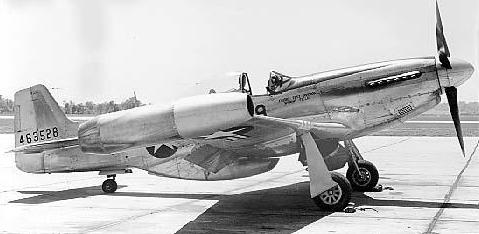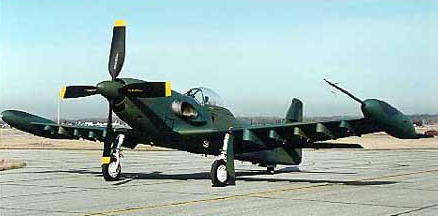Enforcer
Jets45 P
51 Mustang
The Jet "Mustang" After 1945
|
Later on in 1947 ramjets were fitted
on to the wing tips of a "Mustang" again in an attempt to
improve performance, tests were undertaken from 1947 to1948 with the
same result as the Soviet work on aircraft with added ramjets, an increase
in top speed but with the penalty of high fuel consumption and excessive
drag when the ramjets were not in use..
|
 The P51 fitted with ramjets
The P51 fitted with ramjets
|
Cavalier Turbo-Mustang III & Piper Enforcer
Ground Attack / Close Support Prototype
The Piper
PA 48 "Enforcer"
Specifications for the Piper PA 48 "Enforcer"
Engine: 1x Lycoming T55-9 Turboprop making
2,535hp
Wing Span: 41' 4''
Length: 34' 2''
Height: 13' 1''
Weight: Empty 6,696 lb / Loaded 14,000
lb
Maximum Speed: 403 mph
Range: 921 miles
Crew: 1
Armament: 10 underwing hard points for
a range of armaments including 30mm gun pod, antitank
rockets and bombs
History:
In the late 1960's The Cavalier company (who
now owned the rights to the "Mustang" design) began to explore the
possibility of fitting a turboprop engine to there "Mustang II" a
remanufactured P-51D with a new tail, engine, wing and second seat for an observer
(which was bought by the USAF).
In 1968 the company fitted a Roll-Royce "Dart"510
turboprop engine to a F-51D (N6167U), this was so successful that it was planed
to fit the more powerful Lycomming T55-L-9 turboprop engine. However by this
time Cavalier sole the rights to the "Mustang" to the Piper company.
On the 4/11/1970 the prototype "Turbo-Mustang
III" was delivered to the Piper factory, were Piper undertook the redesign
of the "Turbo Mustang" started by Cavalier, with the fitting of the
Lycomming engine and other modifications (resulting in only 10% of parts in
common with the F 51D) to produced a new aircraft the PA 48 "Enforcer".
The USAF tested the PA 48 "Enforcer"
in 1971 with aircraft fulfilling all expectations, but the USAF showed no interest
in placing a production contract. In September 1981 the Air Force, under pressure
from the US Congress ordered two new aircraft (which took to the air on 9/4/83
and 8/7/83) for a new test program which took place in 1983/84, again no ordered
were forthcoming and the aircraft were placed in storage in late 1986.

